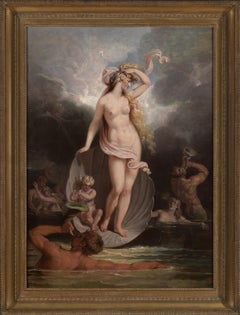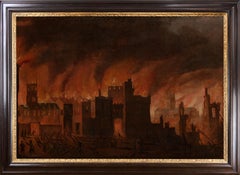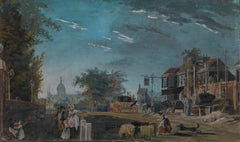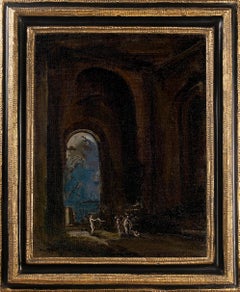Want more images or videos?
Request additional images or videos from the seller
1 of 9
Arthur Devis18th century oil capriccio of Rome1736
1736
Price:$44,115.56
$62,037.51List Price
About the Item
- Creator:Arthur Devis (1712 - 1787)
- Creation Year:1736
- Dimensions:Height: 24.38 in (61.93 cm)Width: 29 in (73.66 cm)
- Medium:
- Movement & Style:
- Period:
- Condition:Preserved in excellent condition and housed in original carved giltwood George II frame.
- Gallery Location:London, GB
- Reference Number:1stDibs: LU150727720482
About the Seller
5.0
Recognized Seller
These prestigious sellers are industry leaders and represent the highest echelon for item quality and design.
1stDibs seller since 2021
5 sales on 1stDibs
Authenticity Guarantee
In the unlikely event there’s an issue with an item’s authenticity, contact us within 1 year for a full refund. DetailsMoney-Back Guarantee
If your item is not as described, is damaged in transit, or does not arrive, contact us within 7 days for a full refund. Details24-Hour Cancellation
You have a 24-hour grace period in which to reconsider your purchase, with no questions asked.Vetted Professional Sellers
Our world-class sellers must adhere to strict standards for service and quality, maintaining the integrity of our listings.Price-Match Guarantee
If you find that a seller listed the same item for a lower price elsewhere, we’ll match it.Trusted Global Delivery
Our best-in-class carrier network provides specialized shipping options worldwide, including custom delivery.You May Also Like
18th Century Neoclassical Oil Painting of the Trojan War: Briseis & Achilles
By James Thornhill
Located in London, GB
James Thornhill (1674-1735)
Oil on canvas
12 x 14 inches;
16 ½ x 18 ½ in. Inc. frame
The subject matter and inclusion of herms on both sides shows the influence of Louis...
Category
Early 18th Century Old Masters Figurative Paintings
Materials
Canvas, Oil
$24,815
H 16.5 in W 18.5 in
The Knight - painting - XVII century
Located in Roma, IT
The Knight is an original oil painting on canvas realized during the XVII century by an anonymous artist.
Provenance: Pecci-Blunt collection. Good condition...
Category
17th Century Old Masters Figurative Paintings
Materials
Canvas, Oil
Early 1800's English Oil Painting Figure in Rural Woodland Landscape, original
By circle of John Constable
Located in Cirencester, Gloucestershire
Artist: English School, early 1800's, circle of John Constable (British 1776-1837)
Title: The Woodland Path
Medium: oil on canvas, framed, unsigned
Size: 12 x 22 inches
Picture: 9 x 18 inches
Provence: from a private collection in East Anglia...
Category
Early 19th Century Old Masters Landscape Paintings
Materials
Canvas, Oil
$4,687
H 12 in W 22 in D 1 in
HUGE 17thC ITALIAN OLD MASTER OIL PAINTING - KING & COURT FIGURES ROMAN BUILDING
Located in Cirencester, Gloucestershire
Artist/ School: Italian School, 17th century.
Title: A King and Queen before court figures, amidst a classical landscape with Roman columns.
Medium: oil painting on canvas, framed
...
Category
17th Century Old Masters Figurative Paintings
Materials
Canvas, Oil
$9,926 Sale Price
20% Off
H 45 in W 60 in D 2 in
Antique Dutch Oil Painting Figures at Sunset by Coastal Estuary with Buildings
Located in Cirencester, Gloucestershire
A River Landscape With A Figure On A Donkey
1800's Dutch School
oil painting on canvas, framed
framed: 21 x 27 inches
canvas: 18 x 24 inches
provenance: private collection, England
...
Category
Early 19th Century Old Masters Landscape Paintings
Materials
Oil, Canvas
$2,646 Sale Price
20% Off
H 21 in W 27 in
Huge 18th Century Italian Oil Painting Shipping in Merchant Port Many Figures
Located in Cirencester, Gloucestershire
The Merchants Port
Italian School, 18th century
oil painting on canvas, framed
framed: 37 x 58 inches
canvas: 32 x 52 inches
provenance: private collection, UK
condition: very good a...
Category
18th Century Old Masters Landscape Paintings
Materials
Oil, Canvas
Fishing at Dawn Old Trading Port with Many Figures Large Oil Painting
Located in Cirencester, Gloucestershire
Fishing at Dawn
English artist after an earlier work (see inscription verso)
signed oil painting on canvas, framed
inscribed verso
framed: 23 x 31 inches
canvas: 18 x 26inches
proven...
Category
Late 20th Century Old Masters Landscape Paintings
Materials
Canvas, Oil
$1,985 Sale Price
20% Off
H 23 in W 31 in
Figures Chatting outside Village Tavern in Mountain Landscape, Period Oil
By 19th century Dutch or Flemish school
Located in Cirencester, Gloucestershire
Dutch/ Flemish School, early 1800's
oil on canvas, framed
framed: 19 x 24 inches
canvas: 13.5 x 18.5 inches
provenance: private collection, France
condition: good and sound condition...
Category
Early 19th Century Old Masters Landscape Paintings
Materials
Oil, Canvas
Large 18th Century English Old Master Oil Painting Portrait of Lady on canvas
Located in Cirencester, Gloucestershire
Portrait of a Lady
English School, 18th century
oil on canvas, unframed
canvas : 31 x 25 inches
provenance: private collection, UK
condition: good and sound condition
Category
Early 18th Century Old Masters Landscape Paintings
Materials
Oil, Canvas
Huge I1600's Italian Old Master Oil on Canvas Jesus at House of Mary & Martha
Located in Cirencester, Gloucestershire
Jesus at the House of Mary & Martha
Italian artist, 1600's
oil on canvas, unframed
Canvas: 32.5 x 56.5 inches
Provenance: Private collection, England
Condition: for a work of such mo...
Category
17th Century Old Masters Figurative Paintings
Materials
Oil, Canvas
More From This Seller
View All18th century allegorical painting of The Triumph of Beauty
Located in London, GB
Exhibited:
London, Royal Academy, 1800, no. 93
What was happening in British history painting in around 1800? In recent discussions of the emergence of a British School of history painting following the foundation of the Royal Academy in 1768, this is a question which is rarely posed and one which is not easily answered. Examination of surviving Royal Academy exhibition catalogues reveals a profusion of artists’ names and titles, few of which remain immediately recognizable, whilst endeavours to explain the impact of exhibition culture on painting - such as the 2001 Courtauld show Art on the Line - have tended to focus on the first and second generation of Royal Academician, rather than young or aspiring artists in the early nineteenth century. This makes the discovery and identification of the work under discussion of exceptional importance in making sense of currents in English painting around 1800. Executed by Edward Dayes...
Category
18th Century Old Masters Figurative Paintings
Materials
Canvas, Oil
Early oil depicting the Great Fire of London
Located in London, GB
The Great Fire of London in September 1666 was one of the greatest disasters in the city’s history. The City, with its wooden houses crowded together in narrow streets, was a natural fire risk, and predictions that London would burn down became a shocking reality. The fire began in a bakery in Pudding Lane, an area near the Thames teeming with warehouses and shops full of flammable materials, such as timber, oil, coal, pitch and turpentine. Inevitably the fire spread rapidly from this area into the City. Our painting depicts the impact of the fire on those who were caught in it and creates a very dramatic impression of what the fire was like. Closer inspection reveals a scene of chaos and panic with people running out of the gates. It shows Cripplegate in the north of the City, with St Giles without Cripplegate to its left, in flames (on the site of the present day Barbican). The painting probably represents the fire on the night of Tuesday 4 September, when four-fifths of the City was burning at once, including St Paul's Cathedral. Old St Paul’s can be seen to the right of the canvas, the medieval church with its thick stone walls, was considered a place of safety, but the building was covered in wooden scaffolding as it was in the midst of being restored by the then little known architect, Christopher Wren and caught fire. Our painting seems to depict a specific moment on the Tuesday night when the lead on St Paul’s caught fire and, as the diarist John Evelyn described: ‘the stones of Paul’s flew like grenades, the melting lead running down the streets in a stream and the very pavements glowing with the firey redness, so as no horse, nor man, was able to tread on them.’
Although the loss of life was minimal, some accounts record only sixteen perished, the magnitude of the property loss was shocking – some four hundred and thirty acres, about eighty per cent of the City proper was destroyed, including over thirteen thousand houses, eighty-nine churches, and fifty-two Guild Halls. Thousands were homeless and financially ruined. The Great Fire, and the subsequent fire of 1676, which destroyed over six hundred houses south of the Thames, changed the appearance of London forever. The one constructive outcome of the Great Fire was that the plague, which had devastated the population of London since 1665, diminished greatly, due to the mass death of the plague-carrying rats in the blaze.
The fire was widely reported in eyewitness accounts, newspapers, letters and diaries. Samuel Pepys recorded climbing the steeple of Barking Church from which he viewed the destroyed City: ‘the saddest sight of desolation that I ever saw.’ There was an official enquiry into the causes of the fire, petitions to the King and Lord Mayor to rebuild, new legislation and building Acts. Naturally, the fire became a dramatic and extremely popular subject for painters and engravers. A group of works relatively closely related to the present picture have been traditionally ascribed to Jan Griffier...
Category
17th Century Old Masters Landscape Paintings
Materials
Oil, Canvas
18th century view of the Elephant and Castle in London
Located in London, GB
Collections:
With Martyn Gregory;
Judy Egerton, 1984, acquired from the above;
By descent to 2014.
Exhibited:
London, Martyn Gregory, Exhibition of English & Continental Watercolours, 1984, no. 94.
London, Lowell Libson...
Category
18th Century Old Masters Landscape Paintings
Materials
Gouache, Vellum
20th century oil painting entitled The Unknown Corner
Located in London, GB
Collections:
Robert Isaacson;
James Draper, New York, 2014.
Exhibited:
Cambridge, The Fitzwilliam Museum, Beggarstaffs: William Nicholson and James Pr...
Category
Early 20th Century Modern Figurative Paintings
Materials
Canvas, Oil
Regency portrait drawing of Arabella Graham-Clarke
By John Downman
Located in London, GB
Collections:
The sitter, and by descent;
Christie's, 19th March 1928, lot 6;
Private collection to 2019
Literature:
G.C. Williamson, John Downman, A.R.A., his Life and Works, Lon...
Category
Early 19th Century Old Masters Portrait Drawings and Watercolors
Materials
Pencil, Watercolor
Regency portrait drawing of Lady Nugent
By John Downman
Located in London, GB
Collections:
With Ellis Smith, London;
Private collection, to 2015.
Literature:
G.C. Williamson, John Downman A.R.A., his Life and Works,
p. lviii no...
Category
19th Century Old Masters Portrait Drawings and Watercolors
Materials
Pencil, Watercolor
Recently Viewed
View AllMore Ways To Browse
Architectural Model Of A Dome
18th Century Capriccio
Column Trajan
Castor And Pollux
Giovanni Paolo Panini
Stubbs Painting
George Stubbs Painting
Earl Of Derby
Tracy Burtz
Two Brothers Painting
Used Acrylic Tank
Used Singlet
Vaux Le Vicomte
Versace Painting
Victor Higgins
Vintage Sand Buckets
Walter Biggs
William Bakaimo



